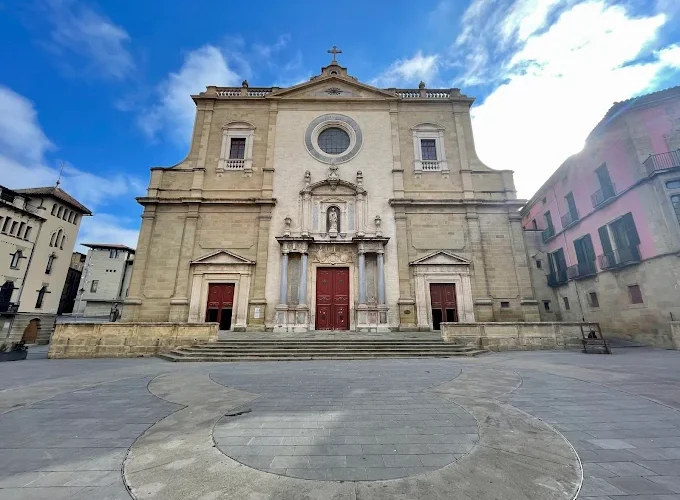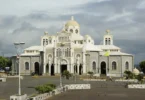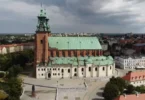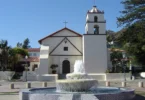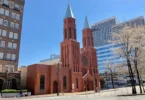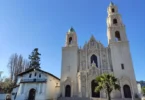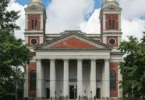Introduction
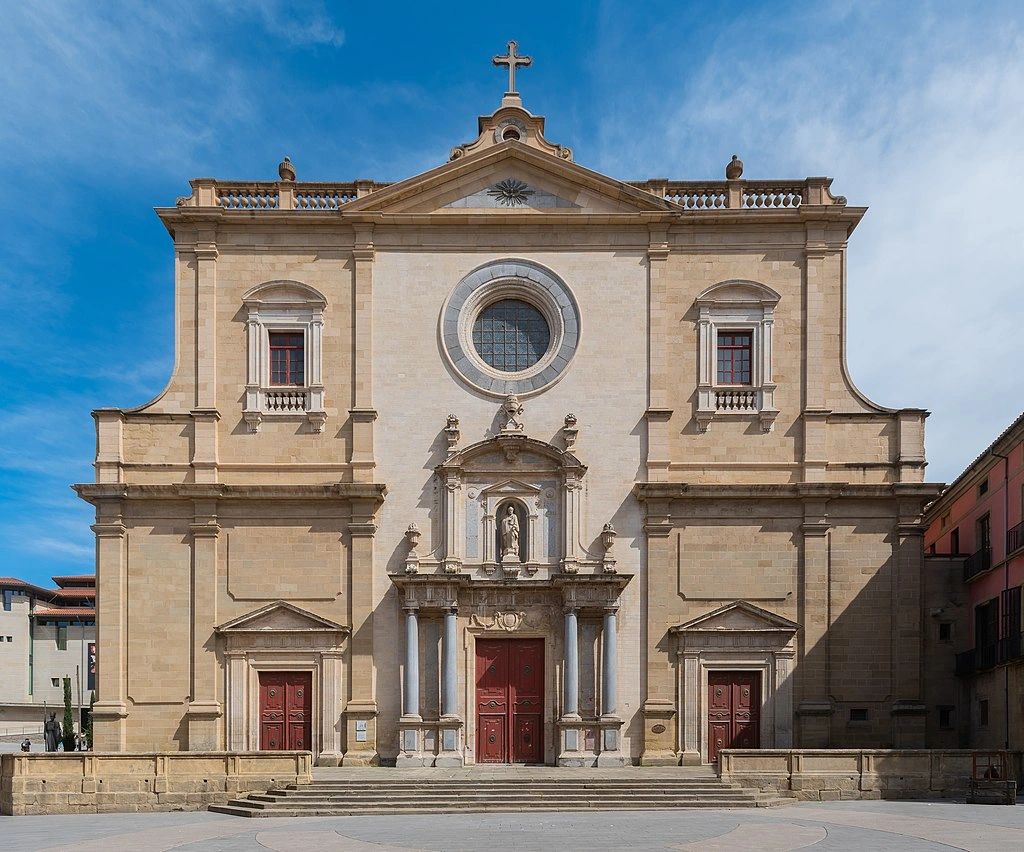
The Cathedral of Saint Peter the Apostle, commonly known as Vic Cathedral (Catalan: Catedral de Vic), is a prominent Roman Catholic cathedral situated in the historic city of Vic, within the province of Barcelona, Catalonia, Spain. Serving as the episcopal seat of the Diocese of Vic, this cathedral stands as a significant religious and cultural landmark in the region. What makes Vic Cathedral particularly remarkable is its rich architectural heritage, showcasing an extensive timeline of European styles. The building embodies a harmonious blend of Romanesque, Gothic (including both Full and Late Gothic phases), Baroque, and Neoclassical elements. This architectural diversity not only reflects the various periods of construction and renovation the cathedral has undergone but also provides a vivid illustration of the evolution of ecclesiastical architecture across centuries in Catalonia and beyond.
Origins and Early Beginnings
The precise location of the original paleochristian and later Visigothic basilica in Vic remains uncertain. However, historical records confirm the existence of a cathedral in Vic as early as the year 516. This early structure was most likely destroyed during the Arab invasion of 717-718. Following the reconquest and repopulation of the area by Count Wilfred the Hairy in 886, a provisional church built from rammed earth was established, alongside the restoration of the bishopric. By the 10th century, as the Christian frontier stabilized, the cathedral was reconstructed in stone. This new building featured three naves and was accompanied by two sister churches dedicated to Saint Mary and Saint Michael.
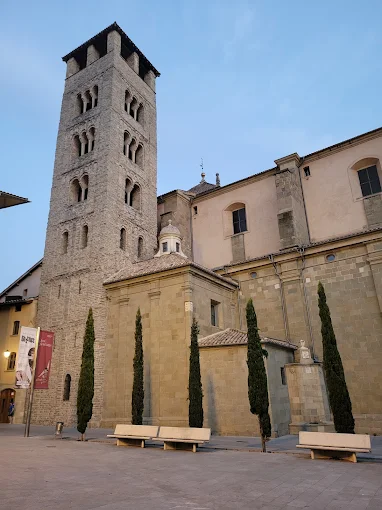
The Romanesque Cathedral of Abbot Oliba
About a century later, under the episcopacy of Bishop Abbot Oliba (1018–1046), the cathedral was rebuilt in a grand Romanesque style, marking a significant milestone in its architectural development. This Romanesque cathedral was consecrated in 1038 by Archbishop Wilfred of Narbonne. The structure featured a distinctive bell tower, standing 46 meters tall and separated from the main church building. Today, the bell tower and the crypt remain as the oldest surviving parts of the cathedral from this period. The crypt is especially notable for its preromanesque capitals, believed to have been salvaged from the 10th-century church. Additional Romanesque sculptural works, including reliefs and capitals from the cloister and portal, are preserved in the Episcopal Museum of Vic, attesting to the cathedral’s rich artistic heritage.
Gothic Additions and Later Modifications
Unlike many other European cathedrals, Vic Cathedral did not undergo a comprehensive Gothic reconstruction. However, important Gothic elements were added over time. The upper cloister was constructed starting in 1318, and the cathedral’s main alabaster altarpiece, crafted by Pere Oller, was completed in 1428. In 1401, Bishop Diego de Heredia added a transept, further expanding the church’s layout. Later, in 1585, the northern door dedicated to Saint John was opened.

Sister Church: Santa Maria la Rodona
Santa Maria la Rodona, a unique round church built as a sister church to the cathedral, was an important religious site for centuries. Bishops celebrated the first Christmas Mass there, while the third was held at Saint Peter’s. The church was rebuilt multiple times, with its final reconstruction completed by Canon Guillem Bonfil in 1140 and consecrated forty years later by Bishop Pere de Redorta.
Unfortunately, Santa Maria la Rodona was demolished in 1787 to make way for the new cathedral building. Its former location, in the present-day Cathedral Square opposite the cathedral façade, is marked by excavated foundations visible in the pavement.
The Neoclassical Cathedral of the 18th Century
The current cathedral’s construction began on September 24, 1781, with the laying of its first stone. The project was designed by Josep Moretó i Codina, a native architect of Vic, who envisioned the building in an academic Neoclassical style. The new cathedral was consecrated on September 15, 1803, and features the Neoclassical façade that still defines the structure today.
The Episcopal Museum and 20th Century Restorations
In 1891, the Episcopal Museum of Vic was inaugurated in the upper floor of the cathedral’s cloister, housing many religious artworks and relics originally associated with the cathedral. The 19th century had left the cathedral in a state of neglect, but the 20th century saw significant efforts to restore and beautify the interior. The renowned Catalan painter Josep Maria Sert was commissioned to decorate the cathedral’s bare walls and ceilings with murals, completing his work in 1930. In 1931, Vic Cathedral was officially declared a Historic-Artistic Monument, recognizing its cultural and historical importance. However, during the early stages of the Spanish Civil War in 1936, the cathedral suffered a devastating fire set by revolutionary mobs, causing the collapse of much of its vaulting.
Post-War Reconstruction and Present Day
Following the civil war, restoration work commenced promptly. During the repairs, the crypt was rediscovered and an ambulatory was constructed to enhance the structure. Josep Maria Sert was invited to repaint the interior murals, which he completed before the cathedral’s reopening in 1945. Since then, Vic Cathedral has remained an important religious and architectural symbol in Catalonia, embodying centuries of history and artistic evolution.
Architecture of Cathedral Basilica of St. Peter, Vic, Spain
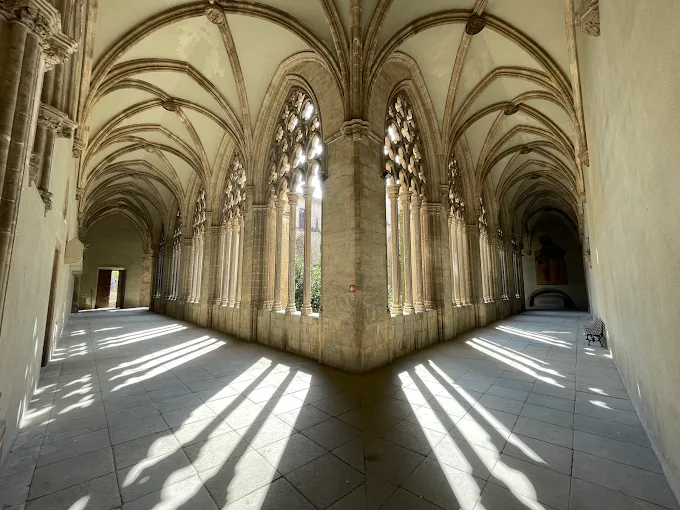
Architect : Josep Moretó i Codina
Architectural style : Romanesque architecture, Gothic architecture, Neoclassical architecture.
Exterior: Neoclassical Façade
Vic Cathedral presents a strikingly austere and somewhat cold neoclassical façade, reflecting an academic architectural approach typical of the late 18th and early 19th centuries. The exterior combines elements of the Doric and Tuscan orders, featuring a white stone façade adorned with a balustrade along the upper edge. The current façade dates from the extensive remodeling completed in 1803 by architect Josep Moretó i Codina. A notable feature is the central rosette at the upper section of the façade, which intriguingly incorporates Romanesque archivolts salvaged from the earlier cathedral structure. This rosette is flanked by two windows, creating a balanced, though somewhat restrained, upper composition.
The cathedral has three entrances corresponding to its three interior naves. The central entrance, aligned with the main nave, is the most richly decorated. It is framed by pilasters and topped with a classical pediment. Above this central portal stands a sculptural representation of Saint Peter, the patron saint of the cathedral, holding a key a traditional symbol associated with the apostle. Despite its historic and artistic value, the neoclassical façade has often been criticized by architectural scholars. Many consider its proportions to be unbalanced, with ornamentation that is minimal and somewhat formulaic. Furthermore, the façade’s application of classical orders is viewed as inconsistent with the classical architectural principles, leading to an impression of visual and structural discordance.
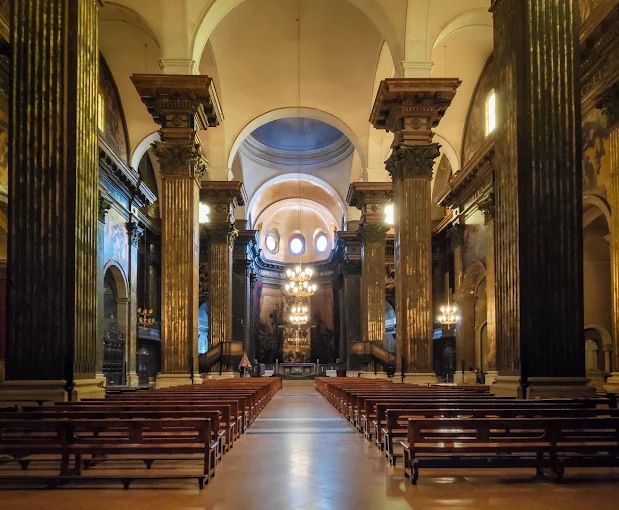
Interior Architecture
The interior layout of Vic Cathedral is composed of three naves of equal height, separated by Corinthian pilasters. However, the pilasters are marked by a notable disproportionality — the capitals and pillars appear mismatched in scale compared to the architrave fragments they support, which detracts from the overall harmony of the design. The church features a pronounced transept crossing the nave, a semicircular vaulted ceiling, and a dome located at the crossing (cruise). The apse is polygonal in shape, typical of neoclassical ecclesiastical architecture. Flanking the side naves, there are series of chapels — two beneath each vault — allowing for additional devotional spaces within the cathedral.
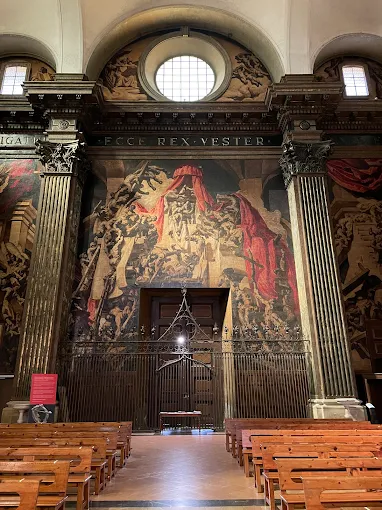
The Murals by Josep Maria Sert
One of the cathedral’s most celebrated artistic features is its extensive mural decoration by the Catalan painter Josep Maria Sert. Between 1926 and 1930, Sert was commissioned to adorn the vast, otherwise bare white walls and ceilings of the cathedral’s interior. His initial project culminated in large oil-painted canvases affixed to the walls, as well as ambitious plans to paint the vaults. Tragically, much of Sert’s original work was destroyed during the Spanish Civil War when a fire ravaged the cathedral in 1936, severely damaging the vaults and dome. Fortunately, many graphic documents of the original paintings survive, preserving the memory of Sert’s first version. After the war, Sert returned to the cathedral to repaint the murals from 1939 until his death in 1945. His disciples completed the remaining paintings, faithfully following his style. This second cycle of murals is noticeably less colorful but maintains Sert’s characteristic style of powerful, voluminous figures with dramatic chiaroscuro contrasts.

Sert’s palette in this later work emphasizes golden hues, browns, ochres, and subtle reds, creating a profound sense of depth and volume through chromatic effects. The murals focus on a comprehensive iconographic program centered on the mystery of redemption, contrasting with the first series, which highlighted the exaltation of Christ and the Church. In the polygonal apse, visitors can observe scenes of the Crucifixion of Christ, framed by depictions of his Burial and Ascension. Along the nave walls are scenes illustrating the Fall of Man and the loss of original justice, while the arches over the side chapels portray the martyrdom of the apostles and evangelists. At the cathedral’s rear, a triptych arrangement of murals depicts contrasting moments: Jesus expelling the merchants from the temple, carrying the cross, and the central scene portraying the sentencing pronounced by Pontius Pilate. Additionally, the lunettes in the ambulatory were painted by Sert’s assistant, Miquel Massot i Tetas, who recreated the Beatitudes originally painted by Sert but destroyed in 1936.
Unfulfilled Artistic Projects
In 1947, painter Felip Vall i Verdaguer won a competition to decorate the cathedral’s vaults. Despite his efforts and the creation of a detailed model and preparatory drawings, the project failed to materialize due to a lack of funding. These materials remain preserved as a testament to the unrealized vision for further artistic enhancement of the cathedral’s interior.
Altarpiece, Chapels, Crypt, and Cloister of Vic Cathedral

The Main Altarpiece
The main altarpiece of Vic Cathedral is a remarkable work crafted from alabaster between 1420 and 1427. Positioned prominently on the wall of the girola (ambulatory), this masterpiece was created by the renowned sculptor Pere Oller. The altarpiece is dedicated to the Virgin Mary and Saint Peter, reflecting the cathedral’s devotional focus on its patron saint and the Virgin. This exquisite piece was generously donated at the beginning of the 15th century by Bernard Despujol, a notable benefactor. The altarpiece is distinguished by its delicate sculptural details and serves as a central liturgical and artistic focal point within the cathedral.
Baroque Chapels
On the northern side of the cathedral, visitors encounter a series of Baroque chapels, which represent the earliest phase of an ambitious 17th-century project aimed at expanding the cathedral complex. One of the most significant chapels is the Chapel of Sant Bernat Calbó, located beneath the cathedral’s Romanesque bell tower. This chapel was designed by the architect Jaume Vendrell of Mataró in 1633. It honors Saint Bernat Calbó, who served as Bishop of Vic from 1233 to 1243 and played a role alongside King James I of Aragon in the conquest of Valencia. His remains are enshrined in a large silver-plated reliquary box, an exquisite work by the goldsmith Joan Matons, created between 1700 and 1728. Another noteworthy chapel is the Chapel of the Virgin of Montserrat, which houses the tomb of Bishop Josep Torras i Bages, a prominent ecclesiastical figure. This chapel also features a poignant sculpture of a dead Christ by the acclaimed sculptor Josep Llimona i Bruguera, adding profound spiritual and artistic depth to the space.
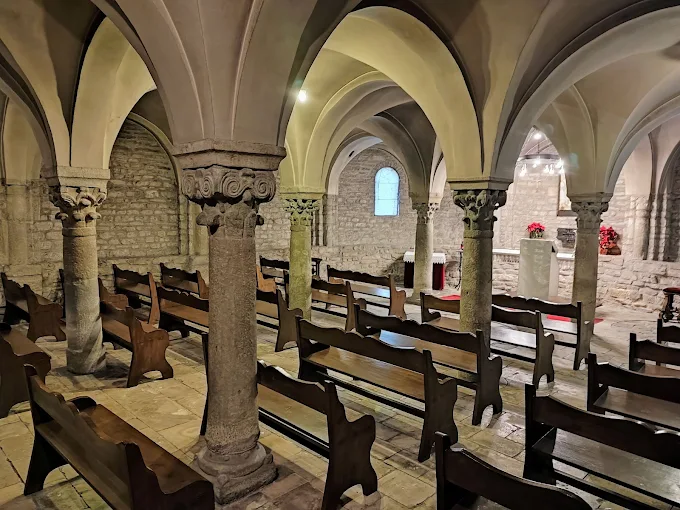
The Romanesque Crypt
Beneath the cathedral lies its ancient crypt, dating back to the Romanesque cathedral consecrated in 1038. The crypt is of great historical significance, preserving architectural elements that predate the Romanesque period itself. Notably, the capitals within the crypt are even older, having been repurposed from the earlier pre-Romanesque cathedral that once stood on the site. This continuity highlights the cathedral’s deep historical roots and the layers of architectural evolution it embodies.
The Cloister of Vic Cathedral
Vic Cathedral’s cloister is an exceptional architectural ensemble divided into two distinct levels, each showcasing a different historical style. The lower cloister dates back to the 12th century and is Romanesque in design, characterized by its robust, rounded arches that convey a sense of solidity and timelessness. This level also houses the entrance to the chapter room, a sacred space consecrated in 1360, featuring a rectangular layout covered by an elegant octagonal vault and a small square apse at the back. In contrast, the upper cloister was constructed in the 14th century in the Gothic style by master builders Despuig, Lardenosa, and Valls. It is renowned for its striking beauty, with a distinctive gallery adorned with double windows that open inward toward the cloister’s serene garden and outward to the surrounding city, creating a graceful connection between the cathedral’s spiritual interior and the urban environment. Additionally, the cloister preserves a finely crafted Gothic door that leads into the chapter room. At the heart of the cloister lies the tomb of Jaume Balmes, a distinguished Catalan philosopher born in Vic. His grave is crowned by a statue sculpted by Josep Bover in 1853, originally intended for the city cemetery but moved to the cloister in 1865, thereby enriching this sacred space with a profound intellectual and cultural significance.
Feast Day
Feast Day : 22 February
The Cathedral Basilica of St. Peter in Vic, Spain, celebrates its feast day on June 29th, the Feast of Saints Peter and Paul, honoring its patron saint. Another important observance is the Feast of the Chair of Saint Peter on February 22nd.
Church Mass Timing
Monday to Saturday : 9:00 am
Sunday : 11:30 am
Church Opening Time:
Monday to Sunday : 10:00 am – 1:00 pm, 4:00 pm – 7:00 pm
Contact Info
Address : Cathedral Basilica of St. Peter
Carrer del Cloquer, 5, 08500 Vic, Barcelona, Spain
Phone : +34 938 86 44 49
Accommodations
Connectivities
Airway
Cathedral Basilica of St. Peter, Vic, Spain, to Girona–Costa Brava Airport, distance 41 min (55.5 km) via C-25.
Railway
Cathedral Basilica of St. Peter, Vic, Spain, to Vic Plaça de l’Estació, distance between 6 min (1.6 km) via Passeig d’En Pep Ventura.

